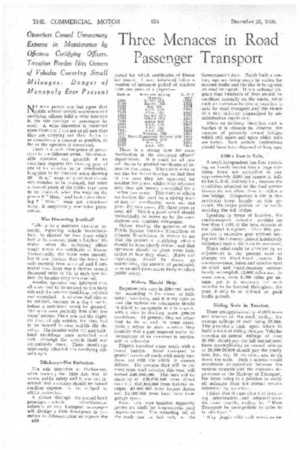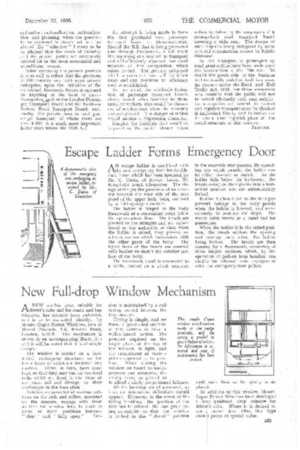Three Menaces in Road Passenger Transport
Page 34

Page 35

If you've noticed an error in this article please click here to report it so we can fix it.
NO sane person can but agree that public service vehicle examiners and certifying officers fulfil a vital function in the safe carriage of passengers by road. A wide discretion is conferred upon them and I am not at all sure that they are carrying out their duties in as considerate a manner as possible, so far as the operator is concerned.
There is a wide divergence of procedure in the different areas. No reasonable operator can grumble if an examiner requires the steering gear of one of his vehicles to be overhauled, king-pins to be renewed when showing 20 "thou." wear, or a cracked chassis side member to be replaced, but when universal joints of the spider type have to be renewed, when the wear on the pins is 9 " thou," and brake pins showing 7 "thou." wear are considered scrap, it suspiciously resembles persecution.
Was Discarding Justified?
Talking to a northern operator, recently, regarding vehicle re-certification, he showed me four tyres which had to be removed from a Leyland 32seater before the certifying officer would renew the certificate of fitness. Undoubtedly, the tyres were smooth, but it was obvious that the tread had only recently been worn off and I estimated that there was a further several thousand miles of life in each tyre before the breaker strip was reached.
Another operator was informed that all seats had to be secured to the body side and the interior mouldings polished and varnished. A window had also to be refitted, because of a slight rattle, before a certificate could be granted. The seats were perfectly firm after five years' service. There was not the slightest trace of side wobble, but they had tc be secured in case wobble did develop. The interior waist rail and bulk. head mouldings were scratched and dull, although the vehicle itself was scrupulously clean. These mouldings apparently offended the certifying officer's eyes.
efficiency—Not Perfection.
The sole intention of Parliament, when framing the 1930 Act, was to secure public safety and it was not intended that operators should he caused needless expense, or be obliged to attain perfection.
A glance through the second-hand passenger vehicle advertisement columns of any transport newspaper will divulge a wide divergence in procedure in different areas as regards the B28 period for which certificates of fitness are issuea. I have tabulated below a number of instances picked at random from one issUe of a paper :—
A.E.O. (32)
1941
There is a strong case for 1li
standardization in the certifying officers' departments. It is usual for all new vehicles to he granted certificates of fitness for five years. When such vehicles are due for re-certification we find that in one area they are approved for another five years, whilst in an adjacent area they are merely re-certified for a further two years. This state of affairs emphasizes the need for a sliding scale of lees for certificates, such as: one year, El; two years, 1.2; three years or over, £3. This is a point which should undoubtedly be taken up by the associations and combine companies. Before leaving the question of the Public Service Vehicles (Conditions of Fitness) Regulations, it occurs to me that the powers of certifying officers should be more clearly defined and that operators should be given some indication of how they stand. Rules and regulations should be drawn up enumerating I he amount of permissible wear on such parts as are likely to affect public safety.
Makers Should Help.
Requirements vary in different localities, according to the views of individual examiners, and it is my opinion that the various manufacturers should be asked to co-operate in this respect, with a view to drafting more precise conditions. At present, they are reluctant to do so and, in some cases, politely refuse to state whether they consider that a part removed under the instructions of an examiner is serviceable or otherwise, Pilgrim travelled many roads with a heavy burden. Road transport in general travels all roads with many burdens, but with one which it cannot deliver. The revenue that will be derived from road vehicles, this year, will exceed £80,000,000. This sum will be made up of £30,500,000 from direct taxation, £40,500,000 from fuel-tax receipts, £1,000,000 from import duties and £8,000.000 from local rates from garage space.
From this vast taxation niggardly grants are made for long-overdue road improvements The mounting toll of the roads can be laid only at the Government's door. Roads built a century ago are being made to suffice for modern traffic and the slur is being cast on road transport. It is a national disgrace that hundreds of lives should be sacrificed annually on the roads, when • such an excessive burden of taxation is paid by road transport and the future of a new industry jeopardized by administrative ineptitude.
When an industry shoulders such a burden it is irksome to observe the number of privately owned bridges which still exists and upon which tolls are levied. Such archaic institutions should have been disposed of long ago.
1500 a Year in Tolls.
• A small independent bus firm operating an hourly service into a large northern town are compelled to pay approximately £500 per annum in tolls to the L.N.E. Railway Co., because the conditions attached to the road service licence do not allow them to utilize a free bridge. Congestion is rife in this particular town, largely on this account, the major portion of the traffic avoiding the toll bridge.
Speaking in terms of taxation, the road-transport industry provides no less than 1-11th of the total revenue of the United Kingdom. That this proportion is excessive goes without saying and the industry cannot indefinitely withstand such a drain on its resources.
Slight relief could be afforded by an adjustment in the present scale of charges for Road Fund licences. In numerous cases, buses and coaches used on short and supplementary services barely accomplish 10,000 miles and, in some cases, even 5,000 miles per annum, yet it is necessary for such vehicles to be licensed throughout the year, if only to be utilized at peak traffic periods.
Sliding Scale in Taxation.
There are approximately 46,000 buses and coaches on the road, to-day, the average mileage of each being 32,000. This provides a basis upon which to build a scale of sliding charges. Vehicles covering an annual mileage of over 30,000, should pay the full annual rate; those accomplishing an annual mileage of 25,000-30,000 should pay the yearly rate, less, say, 15 per cent., and so on down the scale. Such a scheme would necessitate co-operation between the various councils and the statistics department of the Ministry of Transport, the latter being in a position to verity all mileages from the annual returns submitted by operators.
I think that the question that is causing industrialists and administrators the most trouble, to-day, is: " Must Transport be monopolistic in order to be effective? "
Why juggle with such words as co ordination, rationalization, nationalization, and planning, when the question to be answered is clearly set out as above? By " effective" I mean to be so efficient that the needs of industry and the general public are adequately catered for in the most economical and expeditious manner.
When reviewing the present position it is as well to reflect that the greatness of this country was built upon private enterprise, upon the initiative of the individual. Economic theory is opposed to anything in the form of quasimonopolies, „each ats the London Passenger Transport Board and the Northern Ireland Road Transport Board, and, to-day, the private man in road passenger transport, of whom there are over 5,000, is a much more important factor than before the 1930 Act.
An attempt is being made to form the first provincial road passenger transport board at Stoke-on-Trent. Should the Bill that is being promoted pass through Parliament, it will mark the beginning of a new era in transport and will effectively wipe out that small measure of free competition which exists to-day. The greatest safeguard which a consumer has will be taken away and any incentive to efficiency may be annihilated. ,
To my mind, the wholesale formation of passenger transport boards alone, would bring hardship to thousands of workers, who would be thrown out of employment when the economy axe was ground. The danger of strikes would assume a frightening character.
Imagine the hardship that would be imposed on the public should strike
action be taken by the employees of a monopolistic road transport board covering a wide area. The danger of such disputes being instigated by some political organization cannot be lightly dismissed,
In the transport of passengers by road great strides have been made since the introduction of the 1930 Act. No doubt the goods side of the business will eventually stabilize itself in a similar manner under the Road and Rail Traffic Act, 1933, but those extremists who consider that the public will not be served efficiently until semi-socialistic monopolies are formed to control and regulate transport must be checked if individual liberty and initiative are to retain their rightful place in the social structure of this country.
TRANSEX,












































































